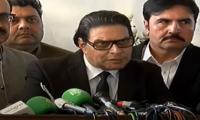KARACHI: The 27-page detailed ruling by Justice Syed Mansoor Ali Shah and Justice Jamal Khan Mandokhail further highlights the well-documented critique regarding the discretionary powers vested in the office of the Chief Justice of Pakistan, say legal experts.
Is there a split in the Supreme Court and what does the justices’ observation regarding a ‘one-man show’ mean? Lawyer and TV host Muneeb Farooq says that the issue of a ‘one-man show’ or judicial activism “has been there ever since”. He is quick to point out that “Former CJ Iftikhar Chaudhry was the one who basically exercised this and [he] was praised by a lot of political parties like the PML-N, and also by parts of mainstream media. But this monster of judicial activism now haunts everybody. So yes a lot needs to be changed”. For Supreme Court Advocate Salman Raja, “the one-man show observation is for the future”. He adds that: “There should be rules regarding the formation of benches, if the full Supreme Court can agree on what the rules should be.”
Speaking about the criticism from peer judges regarding the CJ’s powers, lawyer Salaar Khan says that this “has been an issue that has been raised frequently by judges of the Supreme Court in the past as well. Former CJ Asif Khosa, for instance, addressed at length what he called the threats to the judiciary ‘from within itself’. However, despite ideas repeatedly surfacing about rules that may be framed by the SC itself, and even the possibility of legislation, the formation of benches and the decision as to whether or not to take up a case suo motu remains a power confined to the chief justice alone.”
Supreme Court lawyer Faisal Chaudhry agrees that the observation regarding a ‘one-man show’ has been a “conflicting issue” but asks “whether this was a moot point before the Supreme Court”. According to Chaudhry, “the answer will be in the negative -- and therefore it is worrisome to see such a divided Supreme Court.” He adds that “this divide is costing heavily on taxpayers... and it is time to rise above egos and save democracy and the constitution in the larger public interest”.
For lawyer Moiz Jaferii, the “critique of chief justices enjoying too many discretionary powers regarding the fixation of benches and the court’s functioning on its administrative side is well documented and always comes up as a recommended reform point.” He adds that previous CJs too have “shown reluctance in limiting this unfettered and unstructured discretion.” Jaferii explains that “opposition to this dictatorial behaviour, spearheaded by Justice Qazi Isa, has been heard from many points within the bar. Justice Mansoor Ali Shah added his weight to this argument previously when he wrote the order about former CJ Saqib Nisar dissolving the bench to omit Justice Qazi Isa which he refers to in this order. Justice Mansoor had later written a dissent to the manner in which the bench was reconstituted and agreed with Justice Isa that it was beyond the then CJP Nisar to do so.”
On what the detailed dissenting note means for the ruling given earlier by the apex court, Salman Raja says that: “The bench now hearing the matter can decide whether it was 3:2 or 4:3. In any case, the present bench can now issue all the necessary directions, afresh”. As for the provincial election issue currently in court, Raja says the SC “can order elections as soon as possible to the 90-day limit”.
Muneeb Farooq gives a longer view of the issue. He says that the original ruling by the five-member bench -- of March 1 -- is “according to the CJ, very much in the field.... Whereas the other judges -- the four judges who were originally part of the bench -- believe that ever since the two judges who were criticized for having been part of the bench recused themselves, all the other judges were very much part of the bench. Two of them dismissed these petitions from the outset and the other two remained on the bench and gave their verdict later on. So essentially, these petitions were rejected through a majority of 4:3. The status of the ruling given earlier is very much in question because it jeopardizes the existence of transparency of judgments and propriety of the court -- two things that are elementary to any judicial system.”
What happens in the case of the Punjab/KP elections? Says Farooq: “This affects the elections in a way that now no one knows.... We don’t know how it will pan out [today]. Does the SC wish to constitute a full court? That means it is willing to reevaluate the entire issue but if it doesn’t that means the CJ is not budging an inch and that means he gets into a position where he will be castigated by the biggest lawyers’ body in the country -- the Pakistan Bar Council.”
Salaar Khan says that “What this order means [regarding the earlier order] will depend entirely on who decides what it means. A five-member bench of the Supreme Court has already taken up the ECP’s deferment of the election schedule. Unless the CJP decides to form a larger bench or a full court, this bench will likely decide what the majority decision in the previous suo motu is.” He adds that even if “the SC were to hold that the decision was actually 4-3, then it still wouldn’t change [the matter of the Punjab/KP elections] as much as some claim. The constitution still says elections must be held within 90 days. None of the four judges in a 4-3 decision held otherwise. To the extent of Punjab, the Lahore High Court has already held as much. KP is bound by the same constitution. In that it takes us back to where we were weeks ago; it will possibly delay things a bit though. But that, too, is hard to quantify because the ‘original majority’, so to speak, had already allowed the ‘barest minimum deviation’ from 90 days.”
There is little disagreement regarding this view among Moiz Jaferii and Faisal Chaudhry, both of whom call this a “minority view” Chaudhry says that: “The matter before the SC now is regarding powers of the president of Pakistan and the ECP with regard to poll dates. The matter has been settled already by majority judges and no exception can be taken at this later stage”.
For Jaferii, “because the matter is already before the Supreme Court once again, this decision serves mainly to highlight the divide in the court.” He says that this dissenting decision “affects the Punjab/KP elections issue in power terms alone, in that the bench would be cognizant of being a five-member bench and wary of the government’s intent to dodge its directions. This dodging becomes easier when there are more excuses to throw around, as the ECP has shown. The Supreme Court could have taken itself away from this controversy by putting together a full bench. It chose what it thought was an easy way out. Time will tell whether that was in fact the choice made.”
In a Twitter thread on Monday, lawyer Reema Omer says that: “[the] constitution is clear: election must be held within 90 days of PA dissolution. [The] constitution is also clear: independence of the judiciary must be ensured (which includes freedom from undue interference from within). Both are important. And they are not mutually exclusive.” About what she calls the CJ’s “unfettered discretionary powers”, Reema Omer adds that they “are eroding judicial independence from within and impeding on our fundamental rights, including fair trial. This should be of concern to every citizen of Pakistan, regardless of political affiliation.”
Tweeting that the “independence of the judiciary is one of the foundations of our constitution”, she says that “certain segments of the legal profession...considering reform to defend [and] strengthen judicial independence a ‘conspiracy’ against the judiciary is most unfortunate.”
Video putatively shows that Bushra shifted from her vehicle to Gandpur’s placing her bag first and later herself
ECC directed Finance Division to furnish detailed report on Pension Scheme Amendment
Vawda says woman said she would march on D-Chowk but later ran away, while referring to Bushra Bibi
Establishment Division has issued official notifications of these postings and transfers
He says police was effectively held hostage by KP CM and Bushra Bibi during recent PTI’s protest
Maryam says I am really sorry for inconvenience suffered by people, & directed authorities to open blocked roads







